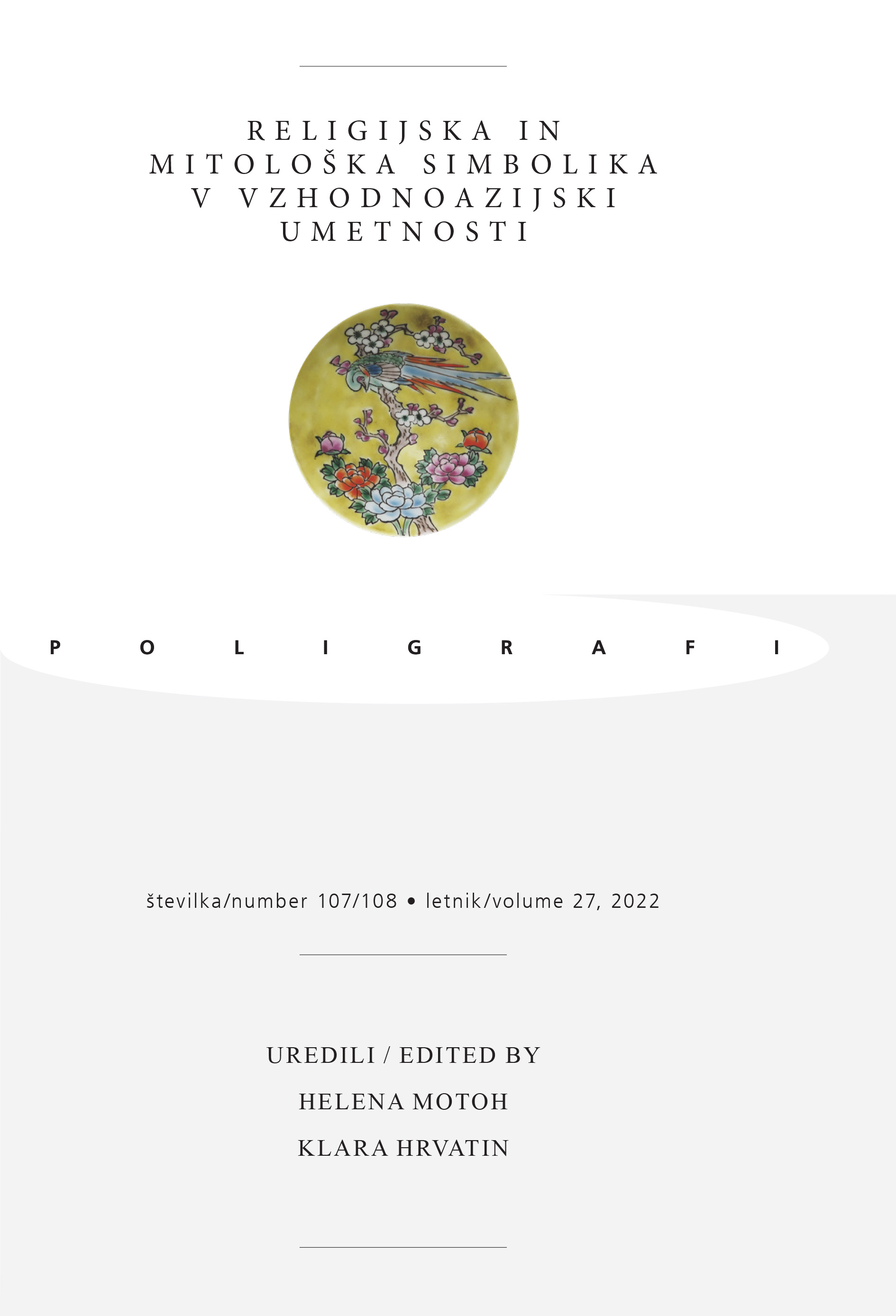Liu Hai teases the golden toad
Auspicious motifs on the wooden mirror frame from the Skušek Collection
DOI:
https://doi.org/10.35469/poligrafi.2022.364Keywords:
Liu Hai, Shouxing, qilin, auspicious motifs, wooden mirror frame, Ivan Skušek Jr., pine, bamboo, plum, lion, magpieAbstract
This paper analyses auspicious motifs on the wooden mirror frame from the Skušek Collection, housed in the Slovene Ethnographic Museum. The auspicious patterns are discussed in the broader context of Chinese cultural and linguistic structures, which in the visual representation of combined plant, animal, and figure motifs, leads to innumerable combinations of rebuses and puns with homonyms based on Chinese historical, literary, philosophical, religious, and mythological tradition. In this way, auspicious motifs developed into a standard decorative scheme, providing a rich source for both literati and artisans, and were exported to neighbouring countries and the West. They are particularly widespread on objects for daily use given as tokens of good wishes for happiness, prosperity, wealth, longevity and progeny, which are also meant to ensure their fulfilment. This can be seen on the wooden mirror frame purchased in Beijing between 1914 and 1920 by naval officer Ivan Skušek Jr. In the first part of the paper, an iconographic analysis of the motifs is made, while in the second part, the messages contained in the visual symbolic codes are analysed in more detail, taking into account the arrangement of the motifs in the completed narrative and the way in which these images are interpreted.
Downloads
References
Bickford, Maggie. “Three rams and three friends: The working lives of Chinese auspicious motifs.” Asia Major 12, št. 1 (1999): 127–158.
Bjaaland Welch, Patricia. Chinese art: A guide to motifs and visual imagery. Tokio, Rutland, Vermont, Singapur: Tuttle publishing, 2008.
Campany, Robert Ford. Making transcendents: Ascetics and social memory in early medieval China. Honolulu: University of Hawaii Press, 2009.
Cheng, Maria, in Eric Choy. “A Window to Chinese art: Translating concepts and culture in auspicious Chinese painting.” V Translation and cross-cultural communication studies in the Asia Pacific, uredila Leong Ko in Ping Chen, 421–435. Leiden: Brill, 2015.
Crick, Monique. Zlato kitajskih cesarjev: zlati predmeti iz obdobja Wanli dinastije Ming. Zbirka Dong Bozhai. Uredila Daša Pavlovič. Ljubljana: Narodni muzej Slovenije, 2018.
Eberhard, Wolfram. A dictionary of Chinese symbols: Hidden symbols in Chinese life and thought. London in New York: Routledge, 1986.
Fang, Jing Pei. Symbols and rebuses in Chinese art: figures, bugs, beasts, and flowers. Berkeley in Toronto: Ten Speed Press, 2004.
Feltham, Heleanor B. “Everyobdy was Kung-fu fighting: The lion dance and Chinese national identity in the 19th and 20th centuries.” V Asian material culture, uredili Marianne Hulsbosch, Elizabeth Bedford in Martha Chaiklin, 103–141. Amsterdam: Amsterdam University Press, 2009.
Fong, Mary H. “The Iconography of the Popular Gods of Happiness, Emolument, and Longevity (Fu Lu Shou).” Atribus Asiae 44, št. 2/3 (1983): 159–199.
Handler, Sarah. Austere luminosity of Chinese classical furniture. Berkeley, Los Angeles, London: University of California Press, 2001.
Insoo, Cho. “Images of Liu Haichan: The formation and transformation of Daoist immortal’s iconography.” Doktorska disertacija, University of Kansas, 2002.
Nozaki, Nobuchika. Kisshō zuan kaidai: Shina fūzoku no ichi kenkyū (吉祥圖案解題:支那風俗の一研究) (Razlaga srečenosnih vzorcev: analiza slik kitajskih navad in običajev) Tianjin: Zhongguo tuchan gongsi, 1928.
Rawson, Jessica. “Ornament as system: Chinese bird-and-flower design.” The Burlington Magazine 148, št. 1239 (junij 2006): 380–389.
Rawson, Jessica. “Ornament in China.” V A companion to Chinese art, uredili Martine J. Powers in Katherine R. Tsiang, 371–391. Chichester: Wiley Blackwell, 2016. https://www.burlington.org.uk/archive/article/ornament-as-system-chinese-bird-and-flower-design.
Russell Coulter, Charles, in Patricia Turner. Encyclopedia of Ancient Deities. New York in London: Routledge, 2012.
Sima Qian 司馬遷. Shiji 史記 (Zgodovinarjevi zapisi). Peking: Zhonghua shuju, 1982.
Skušek, Ivan. Pismo Muzeju umetnosti Minneapolis. Hrani Slovenski etnografski muzej. Ljubljana: neobjavljeno, 3. 5. 1926.
Uchiyama, Jun’ichi. Auspicious animals: The art of good omens. Tokio: PIE International Inc., 2020.
Vampelj Suhadolnik, Nataša. V svetu nesmrtnih bitij: grobna umetnost dinastije Han in njena kozmološka zasnova. Ljubljana: Znanstvena založba Filozofske fakultete, 2017.
Vampelj Suhadolnik, Nataša. »Ivan Skušek ml. kot zbiratelj kitajskega pohištva.« Ars & humanitas: revija za umetnost in humanistiko 14, št. 2 (2020): 45–60. https://doi.org/10.4312/ars.14.2.45-60.
Yang, Shanshan. “Frogs and toads in Chinese myths, legends, and folklore”. Chinese America: History and Perspectives (2016): 77–82.
Williams, C. A. S. Outlines of Chinese symbolism and art motives. New York: Dover Publications, 1976.
Wu, Hung. The Wuliang shrine: The ideology of early Chinese pictorial art. Stanford: Stanford University Press, 1989.
Downloads
Published
How to Cite
Issue
Section
License
Open Access Policy and Copyright
This journal provides immediate open access to its content on the principle that making research freely available to the public supports a greater global exchange of knowledge. Users are allowed to read, download, copy, distribute, print, search, or link to the full texts of the articles, or use them for any other lawful purpose, without asking prior permission from the publisher or the author.
Authors who publish with this journal agree to the following terms:
- Authors retain copyright and grant the journal right of first publication with the work simultaneously licensed under the terms of the Creative Commons Attribution license (CC BY) that allows others to share the work with an acknowledgement of the work’s authorship and initial publication in this journal.
- Authors grant the publisher commercial rights to produce hardcopy volumes of the journal for sale to libraries and individuals.
- Authors are able to enter into separate, additional contractual arrangements for the non-exclusive distribution of the journal’s published version of the work (e.g., post it to an institutional repository or publish it in a book), with an acknowledgement of its initial publication in this journal.





